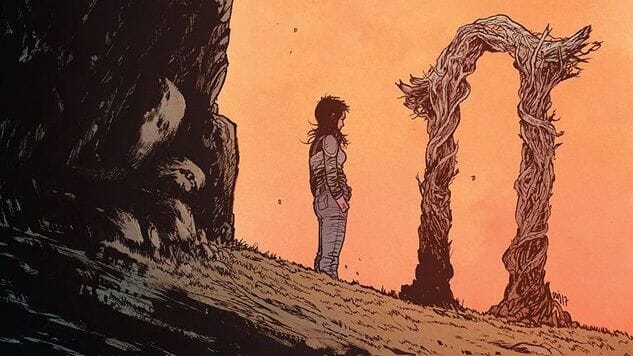Exit Interview: Extremity’s Daniel Warren Johnson Reflects on His Hyper-Violent Masterpiece
Main Art by Daniel Warren Johnson & Mike Spicer
Paste named Extremity one of the best comics of 2017, and for good reason. Space Mullet’s Daniel Warren Johnson had long been one of the comic industry’s best-kept secrets, an “artist’s artist” who hadn’t quite broken through to the wider readership. Extremity, his violent, bizarre Skybound debut with colorist Mike Spicer, finally rectified that travesty. Like an outer-space Fury Road, Extremity is a bloody, fast-paced tale of tribal warfare in a sci-fi world that never conquered class stratification. And like Fury Road’s George Miller, Johnson thrusts his readers right into protagonist Thea’s revenge-driven conflict at breakneck speed, propelling Thea, her brother Rollo, a recovered death machine named Shiloh and the rest of the cast through 12 unforgiving issues.
The finale, which hit shelves yesterday, leaves no character unaltered from their bloody journey, and Johnson has no interest in tidy answers or morals. To commemorate the conclusion of Extremity, Paste exchanged emails with Johnson. Be warned: the conversation covers deep discussion of faith, mortality, free will—and lots and lots of spoilers. Be sure to read #12 before you check out Johnson’s parting words below.
![]()

Extremity #12 Cover Art by Daniel Warren Johnson & Mike Spicer
Paste: Before we get into the deep stuff—how does it feel? You’ve been kind of an “artist’s artist” and fan-favorite for a while now, and now you’ve written and drawn 12 issues of an original story for a major publisher and it ended up on multiple Best of the Year lists, Paste’s included. Was finishing this final issue like crossing a finish line, or was it more of a weight off of your shoulders to have the story off of your work desk?
Daniel Warren Johnson: Honestly? It’s pretty surreal. I spend most of my day indoors, working on my comics in my studio, and sometimes it’s hard to imagine that as I sit down to draw, someone else around the world is sitting down to read my comics. So, it’s even crazier to think that it’s happened for 12 months in a row! I finished the last page of issue #12 in October of last year, and when it was done, I got on a plane the next day to Ireland with my wife and took a week long vacation there. Since then, I haven’t really looked back, simply because I haven’t had time! I’ve been working on a new series, and I recently had a baby girl. I’m sad to see Extremity go, but I’m thankful for the story I was able to make and I’m very proud of it.
Paste: Re-reading the series start to finish, I was struck with how much it reminds me of a Biblical parable, but with (even more) graphic violence. So much of the conflict with Thea, Rollo and the whole cast, really, is about faith—in each other, in institutions, in tradition, in violence. And in the backmatter to one of the issues, you talked about drawing inspiration for a ceremony in the book from an event at your church. How much of this comes from you intentionally reckoning with your relationship with faith and how much is just a byproduct of having these influences present in your life?
Johnson: Something I’m trying to always be careful of is how explicit I am with my beliefs in my own work. It’s very important to me that I never hit my readers over the head with how I feel about something. I’d much rather deliver a story that I feel is of some sort of quality, and let the readers come to their own conclusion about it. That being said, I can never separate myself totally from my own work, and I want to be honest with myself within the story. That means that in order to give the characters life, I need to draw from my own experiences, which includes my faith. All the kinds of faiths you mentioned are incredibly complicated and not easy to answer, which is what I was going for in Extremity. I didn’t want anything to be easy.
Paste: The Old Testament tribal conflict mashes up against some very contemporary themes, too: wealth and power imbalance, climate change, our relationship to technology, weapons of mass destruction. Was Extremity an opportunity to exorcise some of your anxieties and concerns about the current state of the world? Did you ever catch yourself approaching a theme or plot point that felt too real-world and not suited for Thea’s world?
Johnson: The world of Extremity and the things that happen in it were created solely for the character of Thea. I almost had to create her in a vacuum, because the story was mostly about her and the actions she chooses. I had this idea of a girl who goes the opposite way of not only her family, but her enemies as well, and the best kind of world for that tale was the one you read in my pages. Any themes that arise from her arc are ones that are there accidentally. I wasn’t trying to say anything about the world, just about the characters in my head. That being said, I love that there are ways to take Extremity that are deeper than what I created it for. It’s wonderful to have so many eyes on the work and different thoughts about what it may mean.
-

-

-

-

-

-

-

-

-

-

-

-

-

-

-

-

-

-

-

-

-

-

-

-

-

-

-

-

-

-

-

-

-

-

-

-

-

-

-

-











































